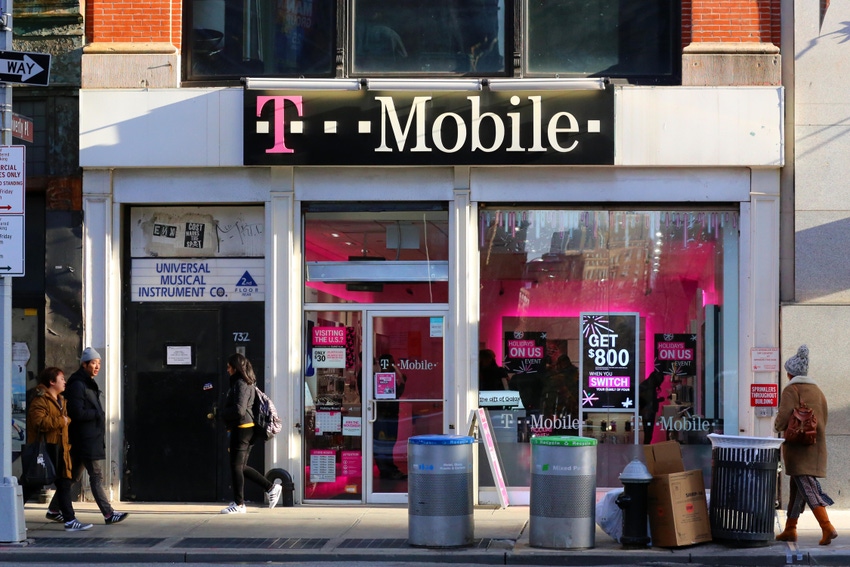T-Mobile, Charter eye spectrum sharing in 42GHz band
'T-Mobile agrees that the technical characteristics of the 42GHz band ... means that the commission may wish to consider a different approach here,' the operator wrote to the FCC.

T-Mobile and Charter voiced support for some kind of spectrum sharing scenario in the 42GHz band.
While Charter's support for that kind of technology isn't much of a surprise, T-Mobile's comments on the topic are noteworthy considering the company typically argues for exclusive, licensed access to spectrum.
"While wireless carriers continue to require additional spectrum that is licensed on an exclusive-use basis, T-Mobile agrees that the technical characteristics of the 42GHz band, along with its separation from other millimeter wave spectrum that has already been licensed, means that the commission may wish to consider a different approach here," T-Mobile wrote in a recent filing to the FCC. "The commission, however, should avoid applying untested, novel sharing approaches to the 42GHz band. Instead, it should implement the nationwide non-exclusive licensing framework currently used in the 70/80/90GHz bands, with a few modifications to ensure that the spectrum will be used efficiently and may be deployed for [a] variety of advanced communications services."
In its own filing, Charter too voiced support for a "unified nationwide, non-exclusive simple shared licensing regime." The company also urged the FCC to implement the same spectrum sharing design across both the lower 37GHz band and the 42GHz band.
"Allocating the lower 37GHz band for non-exclusive use would offer 600 megahertz for innovative new wireless connectivity in the United States," Charter noted. "The allocation of the 42GHz band alongside the lower 37GHz band would of course increase the total spectrum available for innovative new deployments by 500 megahertz."
Charter, for its part, has long eyed the 37GHz band as a way to bolster mobile operations in its planned 3.5GHz CBRS network. The company has said it could offer speeds up to 1 Gbit/s via concurrent operations in the CBRS and 37GHz bands.
Even more mmWave
The 42GHz band sits in the so-called millimeter wave (mmWave) realm of wireless communications. Early 5G operations in the US focused heavily on transmissions in the mmWave bands (those that typically sit above 20GHz). However, transmissions in such bands typically travel just a few thousand feet, and generally cannot pass through obstructions like glass or concrete. Thus, Verizon's early mmWave 5G network only covered a fraction of the US population.
When midband spectrum like 2.5GHz, C-band and 3.45GHz became available, big US network operators like AT&T, Verizon and T-Mobile quickly shifted their focus away from 5G operations in mmWave bands. However, some in the industry believe the carriers will eventually begin expanding their mmWave networks in the future, primarily in high-traffic venues like sports stadiums and airports.
"mmWave 5G offers a way to improve on the current situation because the bands have extremely high capacity that are able to support very large amounts of data traffic and users, although in a small area," wrote OpenSignal analyst Ian Fogg in a post to the network-monitoring company's website.
However, some operators have shown an aversion to 5G in the mmWave bands. For example, operators in South Korea returned their mmWave spectrum licenses back to South Korean regulators.
Qualcomm, for its part, has been pushing the concept of spectrum sharing in mmWave bands for more than a year now.
The importance of sharing
Spectrum sharing has become a hot topic in the US wireless industry in recent years. In general, big US wireless network operators prefer exclusive access to spectrum rather than sharing scenarios. However, other companies – including wireless Internet service providers and cable companies – continue to lobby for more unlicensed or shared spectrum due to the eye-watering prices attached to licensed, exclusive-use spectrum.
The FCC pioneered spectrum sharing technology in the 3.5GHz CBRS band. And now, the agency is considering applying the technology in other bands.
Indeed, the topic of sharing ought to receive even more attention later this month. That's when the NTIA is scheduled to release a report on the 3.1GHz-3.45GHz spectrum band. The US military currently runs radar and other operations in the 3.1GHz-3.45GHz band, but the wireless industry wants to get access to the band for 5G. The NTIA's report is expected to consider the possibility of sharing and exclusive-use licensing paradigms in the band.
About the Author(s)
You May Also Like











